Epson EF-100 Review
Epson EF-100 Review
Great for bright rooms, but not so hot in dark ones.
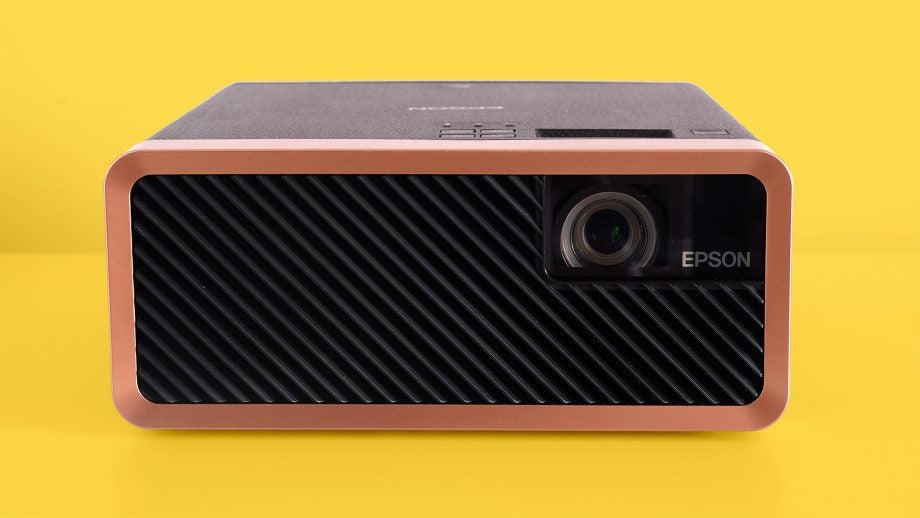
Verdict
A performance that's either hugely impressive or disappointing – the Epson EF-100 packs plenty of brightness into its small body but comes a cropper when used in dark rooms.
Pros
- Very bright for its size
- Smart TV stick-friendly design
- Fairly sharp lens
Cons
- Significant "screen door" effect
- Poor black level
- Speaker distorts with some content
- Poor resolution
Key Specifications
- Review Price: £849
- 2000 lumen laser light source
- "HD Ready" resolution
- Manual focus
- Digital zoom
- 1.01:1 native throw
- Single HDMI input
The Epson EF-100 is the company’s first portable laser projector, coming with the ability to project images up to 150in wide in HD. Weighing 2.7kg and packing Bluetooth, HDMI 2.0 and Epson’s laser technology, the EF-100 aims to be a big-screen wonder in a small package.
The Epson EF-100 is the “world’s smallest” 3LCD laser projector. Parts of this claim are more interesting than others.
Epson has been keen on 3LCD projector tech since the late 1980s. The laser part is more important, since it lets Epson fit 2000 lumen light output into a projector small enough to be a portable unit.
The Epson EF-100 is more impressive during the day than at night, which is almost unheard of for a projector of this size. As such, if you’re looking for a unit to create a living room cinema, we’d think twice.
Epson EF-100 price and availability
The Epson EF-100 was released in 2019 for a price of £849/$999/€1399/CAD$1299/AUD$1699.
Epson EF-100 design – A smart, portable projector that can fit into a rucksack
- Portable size
- Low weight
- Neat design
The Epson EF-100 is smart-looking and small. Epson sent me the black EF-100B version, which has a two-tone finish. Its bronze-gold front surround and leather-texture shell are both plastic, but this helps keep the weight down.
Portability is a big part of the appeal here, so low weight matters. The Epson EF-100 weighs just 2.75kg and is small enough to fit in the average rucksack. At 10cm tall and 21cm wide, this is no room-dominating monster.
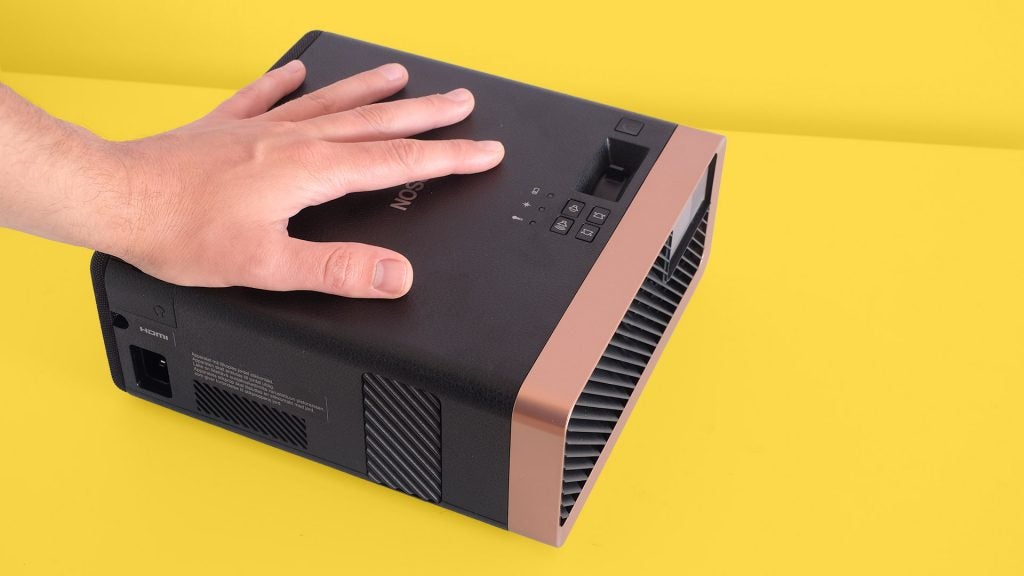
There are some neat parts to the design, too. The back is a fabric-lined removable piece of plastic, much like a speaker grille. A mini “female” HDMI cable sits behind alongside a powered micro-USB cable. The idea is that you can store a plugged-in smart stick, such as an Amazon Fire TV Stick or Now TV Stick, in the recess.
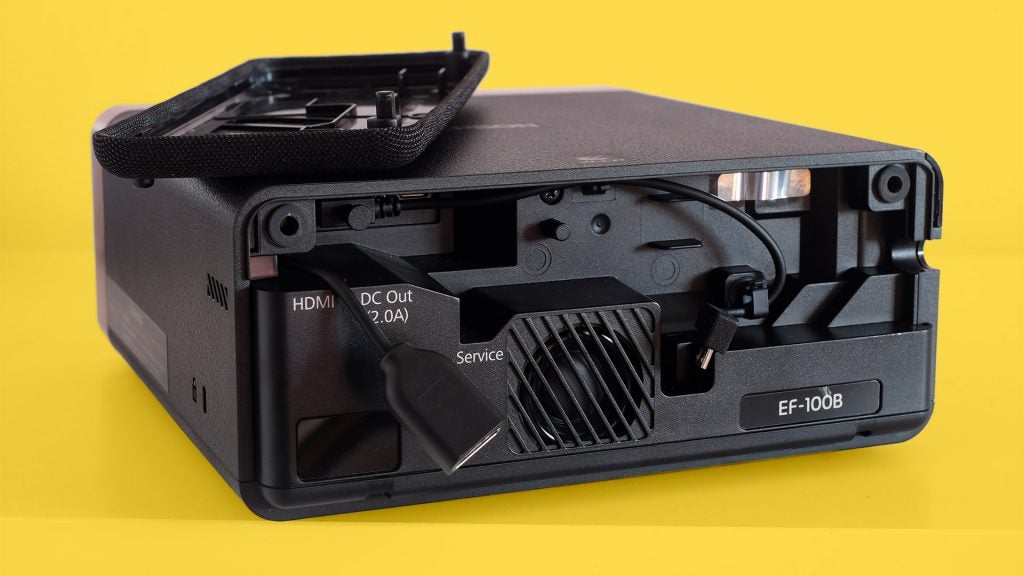
The Epson EF-100’s power cable will then be the only connector you need to worry about when setting up the projector between movie nights. And when such TV sticks switch to USB-C, due any day now, you simply switch the USB cable. The micro-USB one isn’t fused in place.
Epson EF-100 features – Plenty of convenience
- Angle adjustments done with Keystone correction
- Built-in speaker
- Bluetooth connectivity
Actual setup versatility doesn’t compare to many conventional £1000 projectors, though. The Epson EF-100 lacks a zoom lens or lens shift, which are used to compensate when you can’t get the projector itself at the perfect distance or angle, due to the shape or arrangement of the room.
Its native throw ratio is 1.01:1. To project a 100in image, the Epson EF-100 needs to be roughly 2.35m away from the wall or screen. This is a common throw style for a smaller projector, but to make the image smaller you have to use digital zoom. All this does is to shrink the image, and leaves the surrounding area “projecting black”. You’ll want to avoid using this zoom whenever possible.
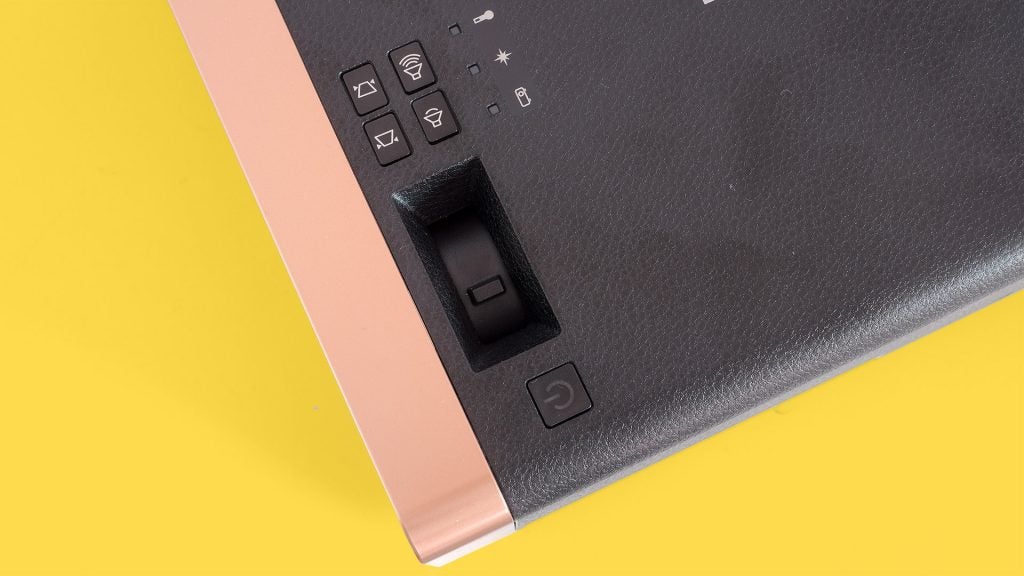
Any angle adjustments have to be made with keystone correction. And again, this deteriorates the quality of the image. The alternative Epson EH-TW6700 is larger, heavier and far more traditional, but it has both optical zoom and lens shift. They’re huge benefits for anyone looking to set up a fixed home cinema.
I used a cheap Tiger-brand laptop/projector stand to get the Epson EF-100 in place without resorting to digital zoom. You’ll want to do something similar if possible, particularly since there’s no flip-stand that lets the projector point upwards slightly.
The built-in speaker brings back some of that convenience I talked about at the start of this review. It has an approx 3.5cm diameter, driver with 5W of amplification. Its volume is decent for an integrated speaker and it can even provide some mild upper-frequency bass.
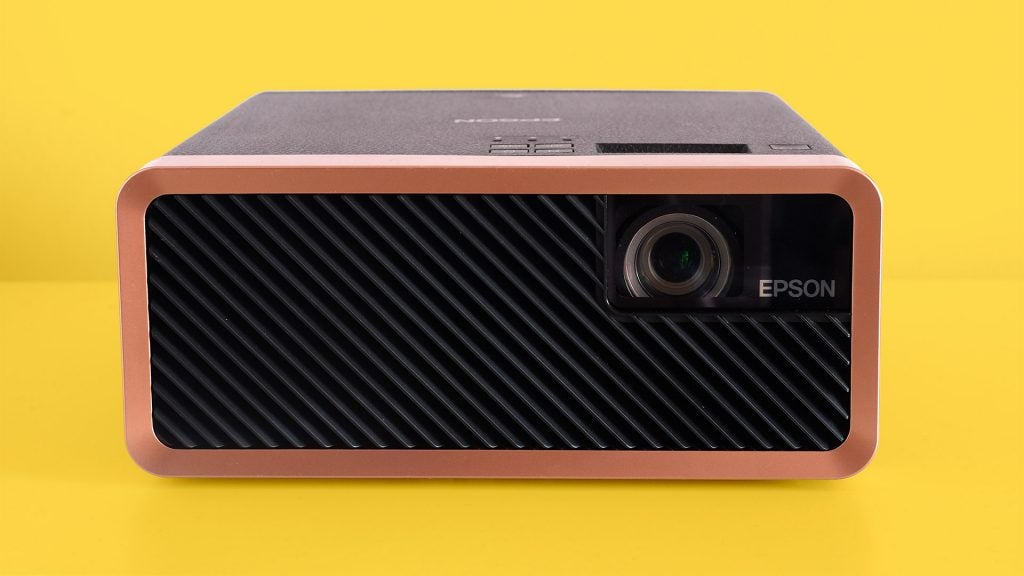
However, certain mid-range frequencies cause ugly-sounding distortion at higher volumes, so you’ll want to keep the level sensible. Alternatively, there’s a neat little 3.5mm headphone jack beneath a flap on the side. You can also use this to attach a better speaker.
There’s even integrated Bluetooth, to let you hook up to a speaker wirelessly. Of course, latency may ruin the experience, depending on the model used. There’s no option to offset the video to match the wireless latency.
You can also treat the Epson EF-100 like a normal projector and hook it up to a receiver and let your surround sound system do the work.
Epson EF-100 image quality – Brightness is great, but the EF-100 isn’t such an astute performer in dark rooms
- HD ready resolution
- Superb brightness
- Disappointing black levels
The Epsom EF-100’s image quality has significant highs and lows. It may be the best semi-portable projector available for some, but it will be no match for DLP-based alternatives for others.
Picture brightness is simply superb for a unit this size. It’s so bright you can use the Epson EF-100 with a 100W equivalent light on in the same room. The light parts of the image still look punchy, colours retain vibrancy and the picture as a whole looks contrasty.
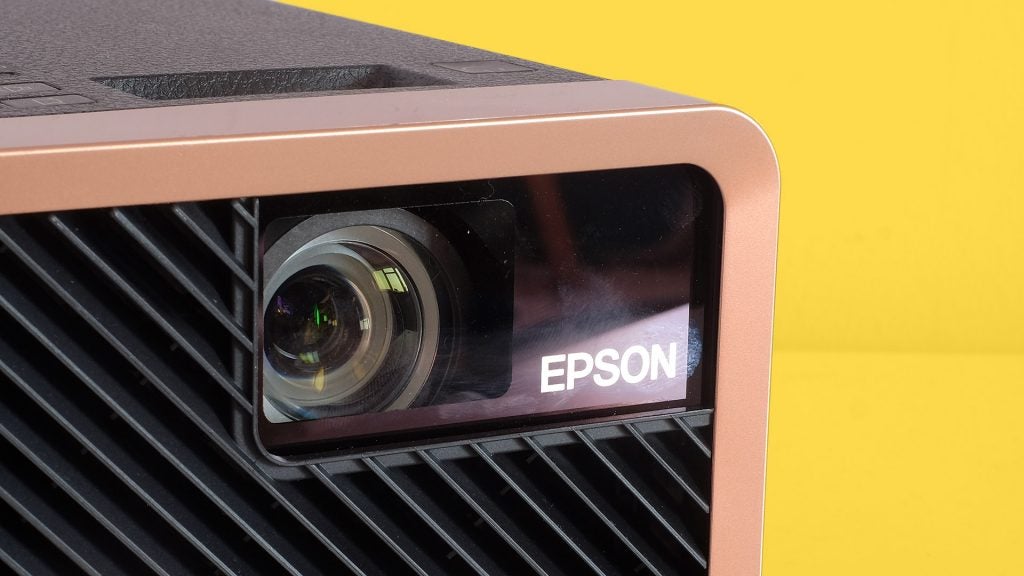
Unless you have a very dark screen the black level is going to be poor in such conditions, but I doubt there’s any mainstream projector at this size that can handle lots of ambient light as well as the Epson EF-100.
Epson rates the projector at 2000 lumens, or 1000 in “eco” mode. Dig into the menu system and you can actually select 11 different power settings between these two min and max levels. The EF-100 is a miniature light canon, and can really achieve its full 150in claimed display size while competing with some ambient light.
Power consumption is impressive, too. Maxed out and powering a SNES Classic (which adds just a couple of watts), the Epson EF-100 tops out at around 132 watts. That drops to around 80 watts at 50% “eco” light output.
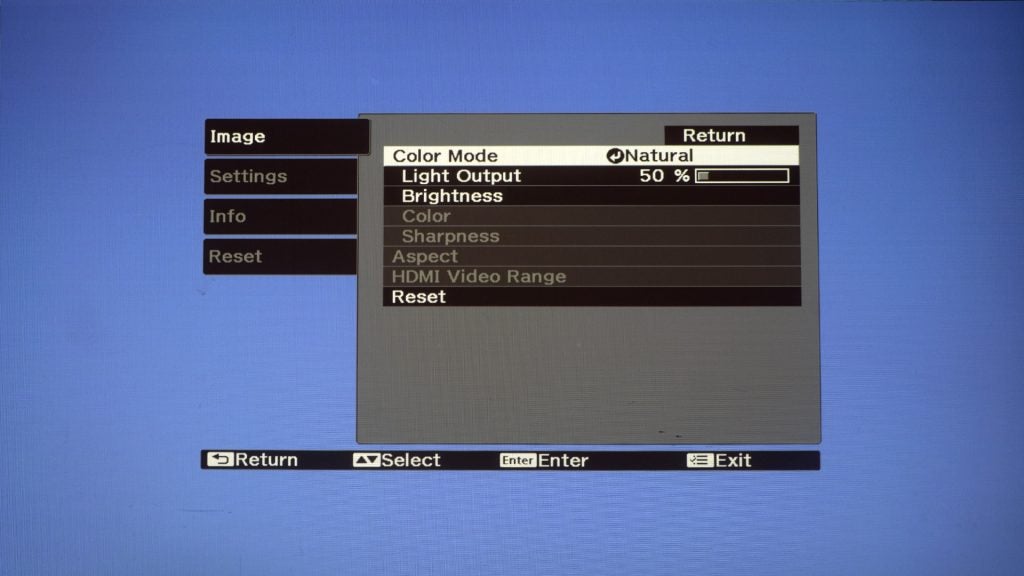
Even noise is minimal. At 30cm I recorded around 20dB of fan noise at max brightness, around 16dB at 50%. It isn’t a whisper-quiet projector, but is unobtrusive considering the light output.
This brightness and power consumption prove the worth of using laser tech in a smaller projector.
The lens is good, too. Sharpness is impressive, and while you have to manually focus with a dial — autofocus is common in lifestyle projectors at the price — the controller is at least smooth and easy to use.
Colour also impresses, as long as you use the right mode. Like your average TV, the Epson EF-100 has dynamic-style modes that oversaturate tones. But the Natural mode gives a good-enough account of skin tones and nature.
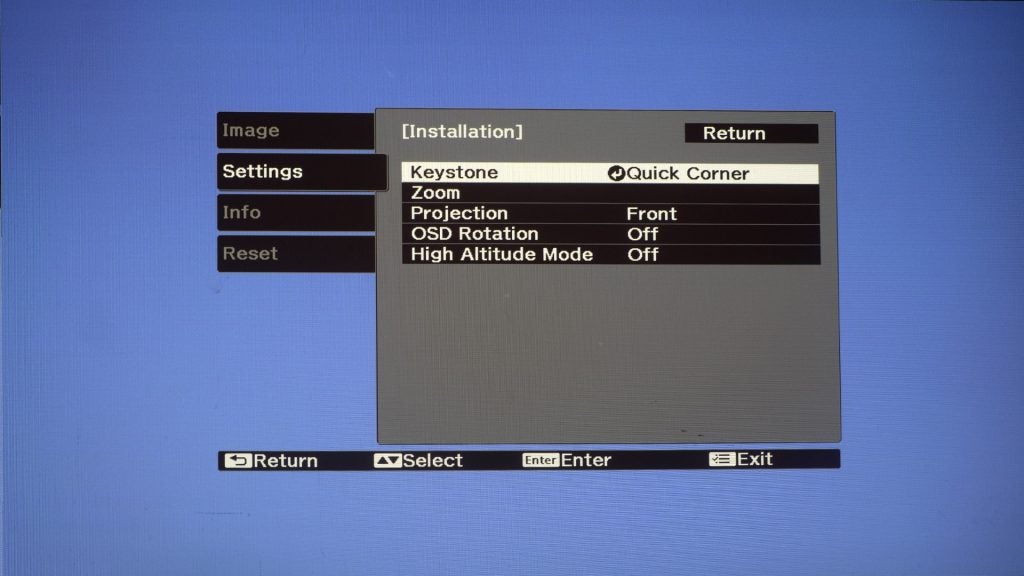
Ready for the bad parts?
As mentioned, the Epson EF-100 suffers from fairly obvious “screen door” effect. This is where you can see the pixel structure, the darker areas around each pixel.
While this can serve to emphasise the sharpness of the optics, it means the EF-100 doesn’t have anything like the smooth quality of a decent DLP projector. The image ends up looking more clinical than cinematic. And the larger a picture you project, the more obvious the screen-door effect becomes. This is only emphasised by the poor native resolution of 1280 x 800 pixels, which seems bizarre at the price.
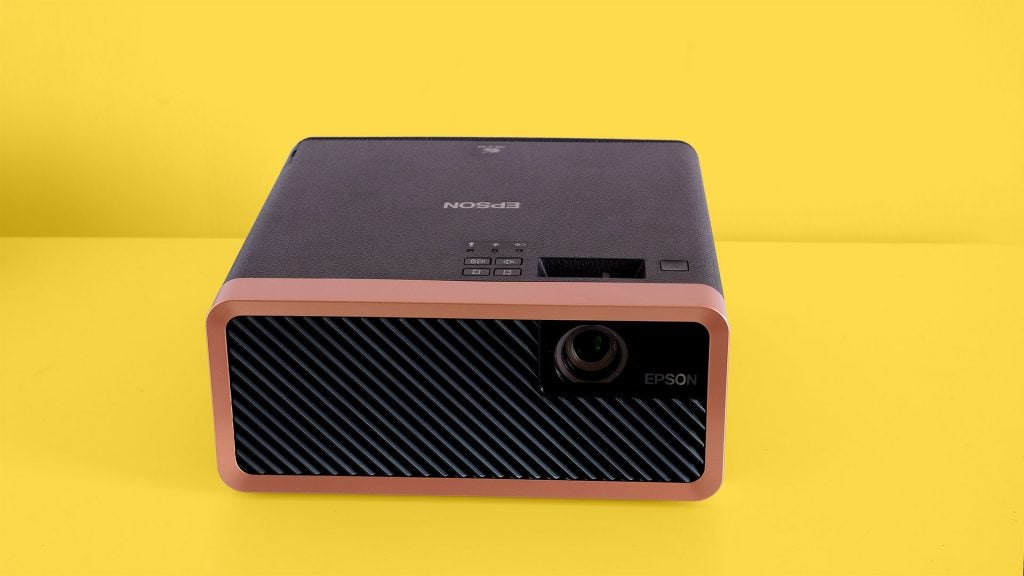
The Epson EF-100’s striking benefits also start to look far less appealing when you set it up in anything approaching a light-controlled room with a standard white projector screen. It just doesn’t have the black level to make films look their best in a traditional projector environment.
Fiddle with the light output, contrast and brightness controls all you like, blacks still look significantly raised, grey-ish in fact.
This projector fares much better in what you’d normally consider worse projector environments. In anything like optimal ones you’ll notice the poor black level and pixel structure far too much. However, get hold of a fairly dark grey projector screen and you may find the Epson EF-100 a “best of both worlds” projector.
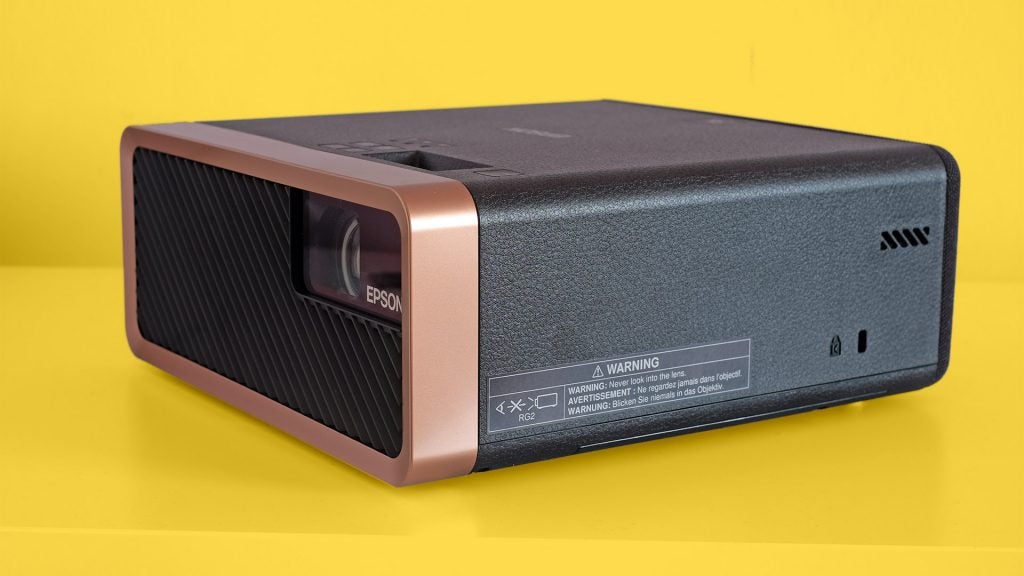
You should buy the Epson EF-100 if…
-
You’re in need of a portable projector
This box can handle challenging levels of ambient light better than virtually any other projector designed for portable or “lifestyle” use, where it will at least be ferried between rooms.
You’re after a projector capable of bright images
This is surely one of the brightest projectors of its size that money can buy, making it far better for use during the day than just about any other model. However, the Epson EF-100’s image quality displays some significant flaws.
-
You looking for an affordable projector
The Epson, for its price, would seem to offer good value, in particular when you take into account how bright it can go.
You shouldn’t buy the Epson EF-100 if…
-
You want to use it for dark rooms
Put it in a dark room in which smaller projectors usually thrive, though, and it falls over. The Epson EF-100 doesn’t have the black level to work as an £800-plus home cinema projector.
-
You want better than HD Ready
The HD Ready resolution won’t do the content you watch any favours. Portable projectors tend to have a low resolution, so if you want better image quality, consider the type of projector that stays put.


